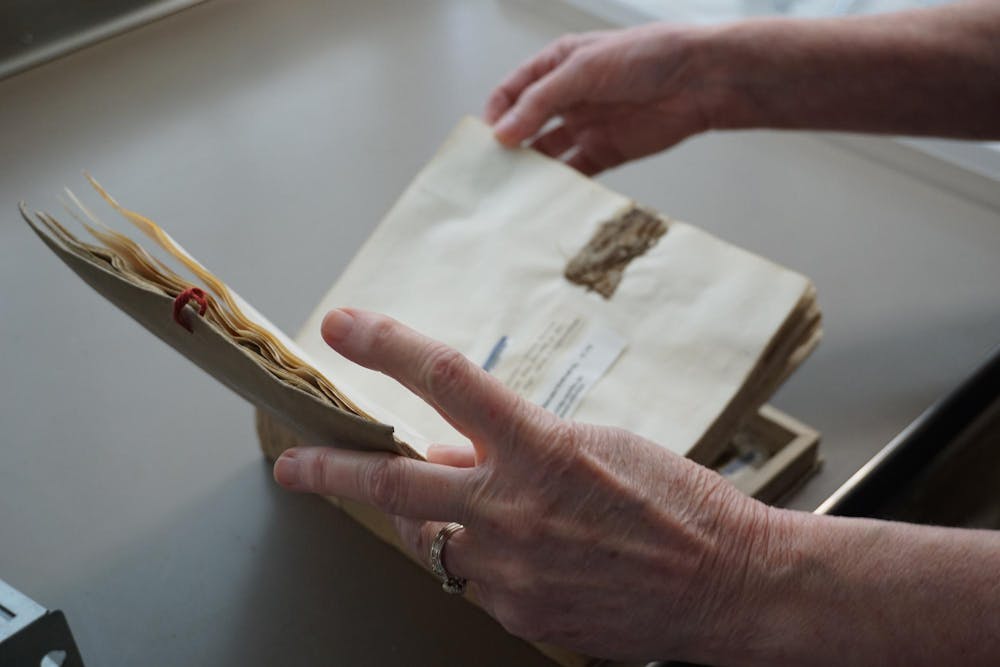Duke Herbarium leaders allege that the recent decision to close the facility was motivated by resource insufficiency within the biology department, as department leaders and administration decided to divert funds away from what they considered an inefficient program to initiatives with more growth potential.
Conversations with faculty and administrators revealed that plans to renovate the Biological Sciences Building prompted leadership to reexamine the utility of existing programs, including the herbarium. Herbarium faculty members say that administrators ultimately decided that the department’s limited funds would be better spent in support of more productive initiatives, namely the Duke University Phytotron, an allegation that University media spokespeople have avoided commenting on.
“[The phytotron’s research is] important, too,” said Kathleen Pryer, professor of biology and director of the herbarium since 2005. “But why does one have to die for the other?”
In a Feb. 25 email to The Chronicle, Dean of Natural Sciences Susan Alberts wrote that “responsibly hosting such a valuable collection at Duke would require that Biology and Trinity prioritize significant, long-term resources … at the expense of many other urgent and strategic priorities.”
“Susan Alberts, you know, she's taking the heat for this, but this is a decision that was made top-down,” said Rytas Vilgalys, professor of biology who established the herbarium’s fungal department. “I know that as a faculty member, I take issue with that. I think the biology department should make this decision. Because it's our collections, right?”
The Chronicle asked Frank Tramble, vice president of communications, marketing and public affairs about herbarium faculty members’ allegations that President Vincent Price, Provost Alec Gallimore and Gary Bennett, dean of Trinity College of Arts & Sciences were involved in the decision, and about the strategic prioritization of the Duke Phytotron over the herbarium.
“Neither President Price nor Provost Gallimore were involved in the decision to relocate the Duke Herbarium collection. However, they fully support the right of deans and department chairs to set their own strategic priorities,” Tramble wrote in a Tuesday afternoon email to The Chronicle.
Tramble’s statement did not respond to allegations surrounding the phytotron. Bennett did not respond to The Chronicle’s Feb. 22 and Feb. 25 requests for comment on the decisions leading up to the herbarium’s closure and details about the biology department’s strategic priorities.
Tramble and Gregory Phillips, executive director of editorial content and media relations directed The Chronicle to Kathryn Kennedy, associate dean for communications and marketing for Trinity College, in response to follow-up questions about the phytotron allegations and Bennett’s involvement in the decision.
“Dean Gary Bennett was consulted about the decision, and he continues to support the relocation of the collections as the best possible way to continue preserving these valuable herbarium specimens for future research,” Kennedy wrote Tuesday evening.
Limited resources
In the original Feb. 13 email to five faculty members connected to the herbarium, Alberts announced that the program would soon shut down due to a lack of available resources to maintain the facility and its extensive collections.
Kennedy wrote in a Feb. 16 email to The Chronicle that the estimated costs “needed to improve the facility and to endow multiple faculty and staff positions would total at least $25 million.”
However, Pryer wrote in an email to The Chronicle on Feb. 14 that “the writing [had] been on the wall” that the herbarium was in danger. Conversations with professors revealed that the facility has been plagued by maintenance issues, funding cuts and general instability since its creation.

In 2000, Duke’s biology department was created by combining the existing botany and zoology departments. Vilgalys said that many faculty were concerned at the time that plant and fungal diversity would suffer from this merger due to a redirection of resources to departments that were more in vogue.
“We merged at a time when, at other universities, there was already a split between organismal vs. molecular biology … a lot of biology departments were going molecular,” he said.
Vilgalys noted that while this split is less of a factor now that the discipline has largely shifted focus toward “integrative biology,” which combines the approaches, the faculty who specialize in studying organisms still feel a sense of “neglect” and “erasure.”
He also expressed that in the 24 years since its creation, the department has yet to solidify a sense of identity, remaining “hamstrung” since the merger. This lack of a common focus has contributed to breakdowns in communication and unclear development goals for administrators, faculty and staff.
Administration attempted to address this issue in February 2023, when Chair of Biology Emily Bernhardt requested a strategic plan from professors of biology Pryer and Paul Manos. They compiled and submitted a report, which identified several initiatives that would secure the program’s future. These included centralizing leadership under a single faculty member, integrating the program more visibly into departmental curricula and strengthening outreach efforts across the University, among others.
According to Pryer, the plan failed to gain traction in the administration, and she was asked to complete a second “vision plan” in May. Pryer’s proposal included a floor plan of a new facility, which could house the herbarium in the Sarah P. Duke Gardens and would allow enough space to store existing collections while also accommodating overflow that the program already experiences.
However, faculty says that communication was limited during the year leading up to the announced closure.
“I don’t think we were in any way asked to talk about compromises or any real details on … what might be sort of a minimum that we could expect to run the facility,” Manos said about the aftermath of the vision plan’s submission.
The strategic plan was originally requested because of looming renovations of the Biological Sciences Building, which are part of a series of facility upgrades — beginning with the Reuben-Cooke Building — that the administration has planned as part of Duke’s Centennial.
“The Biological Sciences Building and some of the other older buildings on campus … have always been sort of neglected,” Vilgalys said. “They have serious problems with water damage and so forth … and I think it’s all come to a tipping point.”
Vilgalys noted that the renovations of the Biological Sciences Building’s “antiquated facilities” are long overdue. However, commencing these renovations would require the herbarium’s collections to be temporarily relocated for at least a few years, which prompted administration to consider new storage options.
“The focus is really right now on research faculty because of their labs and how their labs would need to be recreated in another space — demolition, reconstruction and then coming back,” Manos said. “We’re talking about, minimally, a three-year starting point for when the … building needs to close.”

Somewhere in the year between the strategic plan of February 2023 and Alberts’ February 2024 email announcing the herbarium would close, the administration decided to scale up this temporary location to a permanent closure of the herbarium, and it was this three-year timeline that they provided faculty with to find new homes for over 825,000 specimens.
“The difficult decision to relocate the herbarium involved multiple academic leaders in Trinity College over successive terms and was finalized in January,” Alberts wrote in a Feb. 25 email to The Chronicle. “We are anticipating several years of long-delayed facilities renewal in BioSci before research or teaching could resume in that space.
Alberts maintained that the relocation is “only the beginning of a multi-year process” and that administration is “committed to the herbarium collection’s successful and safe relocation.”
Herbarium faculty remain unsatisfied by this commitment knowing that the herbarium no longer has a future at the University, and they speculated about how shifting priorities for research within the department contributed to the decision.
“The renovations are part of the vision for moving forward, but we certainly don’t know what areas of biology will be reflected in … whatever comes out of that,” Vilgalys said.
Intradepartmental competition
The phytotron, which has its own building behind the French Family Science Center, is a closed facility that can mimic any growing environment and is used as a research greenhouse where students can study the effects of light, humidity, temperature, and other factors on plant growth.
It includes six closed greenhouses, 18 “R” chambers, ten “S” chambers, nine “L” chambers, and twelve “T” chambers — experimental units of various sizes that allow researchers to conduct plant studies using a range of environmental controls.
“It's been my suspicion that [phytotron staff] have been targeting that space since they came here,” Pryer said in reference to the portion of the herbarium’s collections housed in the Phytotron Building. “It's like nothing is sacred, [administration] could just move us out of there.”
Two professors who work with the phytotron — Sheng Yang He, Benjamin E. Powell distinguished professor of biology, and Professor of Biology Lucia Strader — declined to comment on whether or not the herbarium’s closure was related to the phytotron. Greg Piotrowski, who manages the phytotron, did not respond to The Chronicle’s request for comment.
Blake Fauskee, a fifth-year doctoral student in the department of biology who works in Pryer’s lab, feels that the type of botany done at the herbarium is not valued within the biology department anymore.
“The oft-cited constraint of 'limited resources' seems insufficient, especially when juxtaposed with references to Duke's substantial endowment,” he wrote in a Feb. 26 email to The Chronicle. “Absent a compelling rationale, it is difficult to shake the feeling that there is a move to phase out my field of study at Duke.”
Vilgalys added that the herbarium’s function as essentially a records department for plants gives it more of a traditional feel that can seem less exciting to outsiders and “create some kind of stigma as some kind of anachronism.”
In addition to supporting Duke research initiatives, local biological technology companies use the phytotron facilities to do research, and Pryer says that the phytotron’s appeal to outside companies may provide a financial incentive to expand the facility.
But competition between the phytotron and herbarium isn’t the only reason staff thinks administration decided to pull the plug on the herbarium now. According to Pryer and Manos, each of the five professors who manage the herbarium’s collections plans to retire within the next few years. They believe that an aging staff may have “fueled” administration to eliminate the herbarium now instead of going through the process of hiring new staff.
While Vilgalys says that the program has made strides in hiring senior individuals, its recruitment of up-and-coming biologists falls short.
Pryer says that getting rid of the herbarium with its faculty on the brink of retirement will not “just take away a resource, it's going to kill a program.”
“We've been feeling that the kind of science that we do is not appreciated, in the sense that there was never any move to recognize it as we were reaching retirement to try and keep the ranks filled with upcoming [staff],” Pryer said. “We’re all basically going to be gone, the herbarium will be gone, and Duke will never be a leader in biodiversity like it was before.”
In correspondence with the New York Times, Alberts said that the natural science department is not under an obligation to continue hiring herbarium staff.
“We will not dictate to the department that they must hire in these areas in perpetuity,” she told the Times. “We are a university with limited resources.”
Get The Chronicle straight to your inbox
Signup for our weekly newsletter. Cancel at any time.

Zoe Kolenovsky is a Trinity sophomore and news editor of The Chronicle's 120th volume.

Claire Cranford is a Trinity first-year and features managing editor for the news department.

